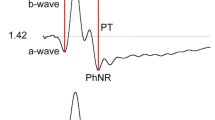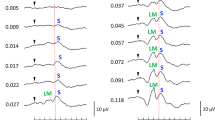Abstract
The clinical utility of submicrovolt full-field 30-Hz (cone) electroretinograms was assessed by quantifying their contamination by electrical and photoelectric artifacts from xenon-flash stimulators and their test-retest variation in patients with retinitis pigmentosa. Artifacts obtained in saline with four commonly used electrodes varied with electrode type and consisted of an early, brief electrical component and a superimposed, extended photoelectric component. Techniques for minimizing these artifacts are described. Electroretinogram recordings from patients with advanced retinitis pigmentosa or congenital rod monochromatism indicate that these artifacts can be virtually eliminated with bipolar lenses. To assess test-retest variation, narrow-band-filtered responses were obtained twice during 6 weeks from patients with amplitudes less than 1 μV; threshold criteria for signficant (p<0.05) change in amplitude with this technique were approximately 0.25 log unit for each of two different systems.
Similar content being viewed by others
References
Henkes HE, van der Tweel LH, van der Gon JJD. Selective amplification of the electroretinogram. Ophthalmologica 1956; 132: 140–50.
Berson EL, Sandberg MA, Rosner B, Birch DG, Hanson AH. Natural course of retinitis pigmentosa over a three year interval. Am J Ophthalmol 1985; 99: 240–51.
Andreasson SOL, Sandberg MA, Berson EL. Narrow-band filtering for monitoring low-amplitude cone electroretinograms in retinitis pigmentosa. Am J Ophthalmol 1988; 105: 500–3.
Van der Tweel LH, Estevez O. Analytical techniques. In: Heckenlively JR, Arden GB, eds. Principles and practice of clinical electrophysiology of vision. St. Louis: CV Mosby, 1991: 231–253.
Sutter EE, Tran D. The field topography of ERG components in man, I: the photopic luminance response. Vision Res 1992; 32: 433–46.
Berson EL, Rosner B, Sandberg MA, Hayes KC, Nicholson BW, Weigel-DiFranco, Willett W. A randomized trial of vitamin A and vitamin E supplementation for retinitis pigmentosa. Arch Ophthalmol 1993; 111: 761–72.
Birch DG, Anderson JL. Longitudinal measures in children receiving ENCAD for hereditary retinal degeneration. Doc Ophthalmol 1991; 77: 185–92.
Dagnelie G, Massof RW. Sub-microvolt electroretinograms: negotiating the pitfalls of photoelectricity and noise. In: Vision science and its applications 1994. Technical Digest Series, Vol 2. Washington, DC: Optical Society of America, 1994: 354–7.
Marmor MF, Arden GB, Nilsson SEG, Zrenner E. Standard for clinical electroretinography. Arch Ophthalmol 1989; 107: 816–9.
Gouras P, Carr RE. Electrophysiological studies in early retinitis pigmentosa. Arch Ophthalmol 1964; 72: 104–10.
Berson EL, Gouras P, Hoff M. Temporal aspects of the electroretinogram. Arch Ophthalmol 1969; 81: 207–14.
Birch DG, Anderson JL. Standardized full-field electroretinography: normal values and their variation with age. Arch Ophthalmol 1992; 110: 1571–6.
Author information
Authors and Affiliations
Rights and permissions
About this article
Cite this article
Birch, D.G., Sandberg, M.A. Submicrovolt full-field cone electroretinograms: artifacts and reproducibility. Doc Ophthalmol 92, 269–280 (1996). https://doi.org/10.1007/BF02584081
Accepted:
Issue Date:
DOI: https://doi.org/10.1007/BF02584081




